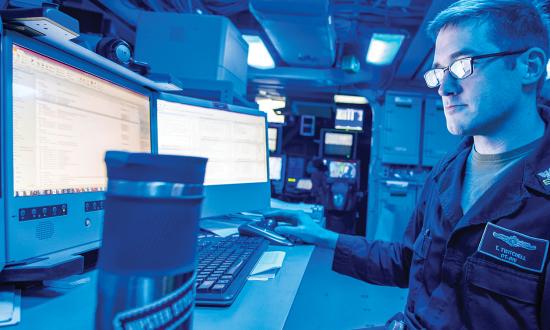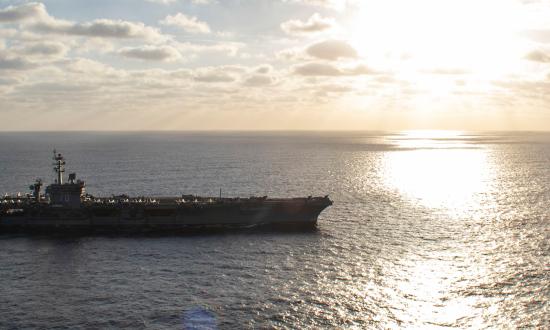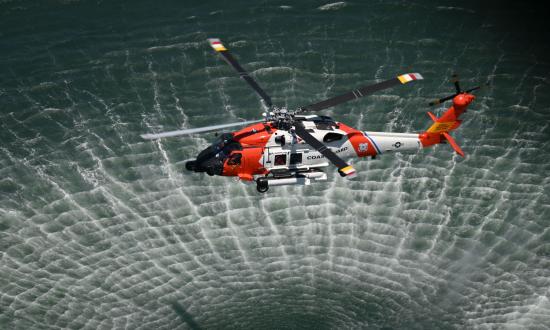Today, naval units must be prepared to deploy into increasingly dangerous and complex operating environments. Unanticipated geopolitical events, such as Hamas’ surprise October 2023 attacks on Israel, can lead to dramatic changes in global Navy force posture overnight, forcing staffs to draw and redraw plans to adapt to new contingencies. Every afloat warfare commander—whether they are responsible for strike, air defense, surface operations, or information warfare—must be able to think on their feet and use all available information about the battlespace to achieve and maintain decision superiority while operating forward.
Data Science at Sea
In November 2022, Carrier Strike Group One (CSG-1), in collaboration with Project Overmatch, established the Navy’s first Data Science at Sea (DS@S) team to create an afloat capability to use intelligence, battlespace, and operational data to fulfill emerging warfare requirements. This effort was the continuation of work by CSG-1’s information warfare team during their 2021–22 deployment, which used Python scripting and the Geographical Information System (GIS) to automate manpower-intensive tasks on board a Nimitz-class aircraft carrier. That initial work was documented in Proceedings in February 2023.
From November 2022 onward, CSG-1’s new DS@S team had three goals:
- Man, train and, equip a mixed uniform and civilian data science team to support
CSG-1 operations throughout the workup cycle and into the 2023–24 deployment. This team would work on board and deploy with the USS Carl Vinson (CVN-70). - Track DS@S performance in terms of warfare commander requirements addressed, projects developed and deployed, and man-hours saved.
- Document the man, train, and equip inputs for integration into the formal Office of the Chief of Naval Operations (OPNAV) Requirements process to support scaling DS@S to other CSGs.
With the support of Project Overmatch, Naval Information Warfare Systems Command (NAVWAR), and Program Executive Office Command, Control Communications, Computers, and Intelligence (PEO-C4I), CSG-1’s DS@S team—comprised of one O-5, two O-4s, one E-6, one E-5, and two civilian GS-13s—achieved all three goals over the past year and a half. DS@S grew from an experimental capability during the 2023 workup cycle to an in-demand data management, software development, and data-analytics production center over the course of CSG-1’s 2023–24 deployment. This improvement in capability and scope can mainly be attributed to three factors: a widely shared understanding that the Navy’s information warfare community is suboptimized by an overuse of PowerPoint as the main conduit for presenting and sharing information; the demand from the afloat warfighters for new and better ways to harness, analyze, and display data; and the DS@S team’s technical expertise and eagerness to work alongside operators and analysts to understand their requirements.
Specific Projects
Though most of DS@S’s work is classified, it is possible to generally discuss the effect the team had on day-to-day operations underway. Consider how the DS@S team on board the Carl Vinson created their first project, DEDUN. Project DEDUN was created when CSG-1’s N2 realized most of his red air analysts were not spending time analyzing flight activity; rather, they were collecting, organizing, and drawing air tracks by hand in PowerPoint. This manpower-intensive process took four to six hours daily and could be challenging to complete in time to support the Daily Battlespace Brief. To solve the problem, the DS@S team automated the aggregation of relevant data, wrote scripts in Python to condition data, and created a pipeline for displaying that data using locally available versions of the ArcPro and ArcEnterprise GIS software. The process of displaying the relevant red air data was shortened from 4–6 hours to 5–10 minutes, which meant analysts could spend time on actual intelligence—looking for the meaning in the data.
In another example, CSG-1’s top priority during the deployment was refining the maritime fires process. In response, the DS@S team designated maritime fires its number one production priority, leading to the creation of two new software projects: PELICAN and HORUS. The DS@S team began work on these projects in October 2023, shortly after deployment began. Members of the team attended daily fires meetings and collected frequent user feedback, which aligned them closely to the users and problem—something that often proves difficult for shore-based software development teams. Both projects reached initial operational capacity in January 2024 and were subsequently used on board the Carl Vinson, fulfilling the warfighter’s request for geospatial correlation to weapon-target pairing (Project PELICAN) and the rapid visualization of find, fix, track, target, engage, and assess (F2T2EA) kill webs (Project HORUS). Automating repetitive routine analysis and production tasks increased product accuracy and significantly reduced manual analyst effort during the 2023–24 deployment. These projects and others were also transferred to CSG-9 and the Marine Corp’s III Marine Expeditionary Force in Okinawa, Japan, at their request. The DS@S team went from ideation to prototyping to deploying capability on three different operational units within three months while underway.
The above represents only a portion of the DS@S team’s work over the past year and a half. During CSG-1’s five-month deployment, the team developed three new projects and eight smaller-scale applications focused primarily on battlespace awareness; counter–intelligence, surveillance, and reconnaissance; and maritime fires support. The DS@S team created a project to automatically generate furthest-on-circles for undetected red units, saving intelligence watchstanders several hours of work each day. The team developed a completely new tool to help plan airwing alert postures based on threat disposition, automating what had been a computationally complex and manpower-intensive process that directly impacted daily operational planning.
Throughout the deployment, warfare commanders and their watchstanders found more use-cases and requested new capabilities—such as tools to automate a manpower-intensive process or a new way to display operational data—and the onboard DS@S team was able to deliver on these requests, typically within days or weeks. During workups, the DS@S team was able to develop a possible solution to a warfare commander problem on a Monday and have a working prototype ready to demo by that Friday.
Over the course of the deployment, the DS@S team developed and maintained more than 30 analytical layers in GUNSS 2.0 (the GEOINT Unified Naval Streaming System), a geospatial visualization tool locally hosted onboard Vinson and available to all shipboard SIPRNet users. These layers significantly improved watchstander situational awareness across the CSG.
Next Steps
DS@S teams can enhance the Navy’s afloat decision-making capabilities, improve battlespace awareness, and respond dynamically to emerging warfare requirements by harnessing the power of data analytics and software development at the tactical edge. As the Navy continues to adapt to an increasingly complex maritime operating environment, the importance of innovative approaches to data analysis and software development that can go fast at the tactical edge cannot be overstated. By scaling the DS@S concept across the fleet and investing in the necessary training and resources, the Navy can establish a sustained rapid innovation capability across the tactical edge, collaborating and scaling the best of breed solutions across the Navy and ultimately enhancing its overall effectiveness and readiness in an evolving threat landscape.






